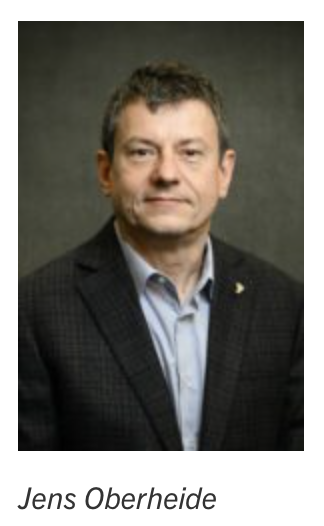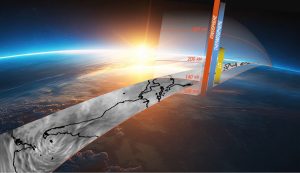Clemson part of team selected to advance in NASA space weather mission competition
June 27, 2024DYNAMIC targets the Lower Thermosphere Ionosphere (LTI) altitude region where the thermosphere’s neutral gas interacts with the coexisting plasma population of the ionosphere, influenced by forcing from above and below. Poorly understood multiscale ripples in this area, as depicted in the gray-scale ground track, are a result of atmospheric wave forcing from below.
A Clemson University professor is part of a team of researchers receiving a $2 million award from NASA for a concept study of a proposed mission investigating the connection between space weather and the Earth’s atmosphere.
Jens Oberheide, a professor in the Department of Physics and Astronomy, is a co-investigator and a science lead in the proposal spearheaded by the University of Colorado Boulder, the Johns Hopkins Applied Physics Laboratory, NASA’s Jet Propulsion Laboratory and the MIT Haystack Observatory.
The team is one of a group of three chosen by NASA in a competition to develop Phase A proposals to enact the space agency’s Dynamical Neutral Atmosphere-Ionosphere Coupling (DYNAMIC) mission. The mission will ultimately design and build a satellite with science payloads to explore fundamental gaps in our understanding of how changes in the lower atmosphere influence the upper atmosphere and low Earth orbit.

“We’re grateful and overjoyed for this opportunity to work together to make our vision of DYNAMIC a reality. With these measurements, we can finally gain an understanding of the critical link between Earth’s atmosphere and space,” said Tomoko Matsuo, principal investigator on the grant and an associate professor in the Ann and H. J. Smead Department of Aerospace Engineering Sciences at CU Boulder.
The team’s project will fulfill science goals recommended by the 2013 Decadal Survey for Solar and Space Physics published by the National Academies of Sciences, Engineering, and Medicine.
Additional partners on the team are Arizona State University, the University of Alaska Fairbanks and the National Center for Atmospheric Research.
Nine month study
Each of the three winning teams are receiving funding for a nine-month concept study, after which NASA will select a single winning proposal.
When launched, DYNAMIC is expected to provide comprehensive measurements of the upper atmosphere in the very low-Earth orbit (VLEO, below 300 km) range — the new frontier for spacecraft operation. This will provide a deeper understanding into how space weather — events generated by activity on the sun and the Earth’s weather — can interfere with satellites, navigation systems and other technology.
Oberheide became part of the 2013 Decadal Survey shortly after he joined the Clemson faculty and has been advocating for the DYNAMIC mission for the past 12 years.
He will serve as science lead for a key objective — how weather impacts space weather — and is responsible for algorithm and data product development.
“DYNAMIC will allow us to finally understand the prevailing space weather conditions in the uppermost reaches of Earth’s atmosphere where most of the manned and unmanned spaceflight takes place. I am excited to provide my students at Clemson the opportunity to work on an exciting new satellite mission that will allow them to become leaders in a field of top national priority,” Oberheide said.
Adapted from releases from NASA, the University of Colorado Boulder and the Johns Hopkins Applied Physics Laboratory
(Image: CU Boulder and APL graphic department)

















